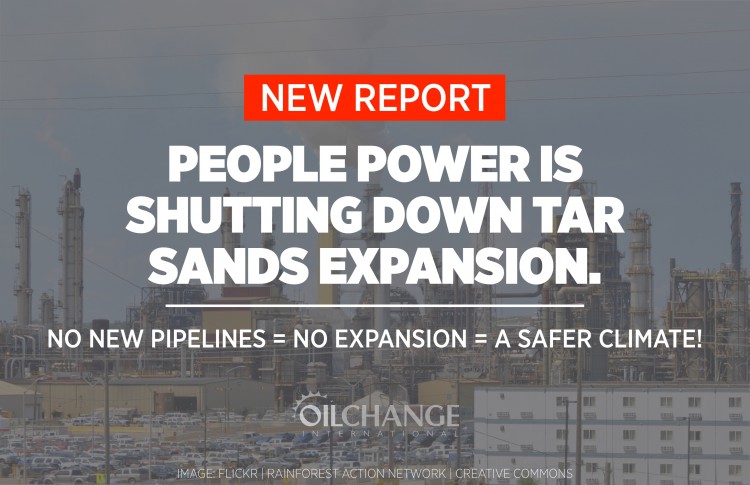Pipeline opposition could end tar sands growth – new analysis
The pipelines exporting tar sands out of Alberta are almost full, according to new analysis released today by Oil Change International. Without major expansion-driving pipelines such as Energy East, Kinder Morgan or Keystone XL, there will be no room for further growth in tar sands extraction and tens of billions of metric tonnes of carbon will be kept in the ground. This would be a significant step towards a safer climate, cleaner water and air, and healthier communities.
“The tar sands have run out of room to grow,” says Hannah McKinnon of Oil Change International. “Production is close to peaking, and now it is time for a recognition that tar sands production has no place in a climate safe world.”
All proposed new pipeline routes out of Alberta are facing legal challenges, opposition by local authorities and regulators, and broad-based public opposition [1]. All of the major projects have been significantly delayed with some cancellations seemingly imminent. No pipeline has been built since 2010, despite active industry efforts.
To assess the impact of these pipeline constraints, Oil Change International built a new and comprehensive model called the Integrated North American Pipelines model (INAP). It finds:
- the current system is 89% full
- the industry will run out of transportation capacity as soon as 2017
Subsequent economic and carbon analysis of the model data finds:
- further growth in the sector is unlikely to be viable without major pipeline expansion [2]
- transporting tar sands by rail is found to be too expensive to justify major new growth
- the emissions savings of no new growth would be 34.6 gigatons of CO2 equivalent (equivalent to the annual emissions of 227 coal plants over 40 years)
“This model shows us what every board room in the sector is stewing over – this industry does not have room for profitable growth,” says Tom Sanzillo, Director of Finance at the Institute for Energy Economics and Financial Analysis. “Under mainstream oil price forecasts, the model shows that market access constraints take new growth from being commercial to uncommercial.”
The model’s findings are released today in a report entitled Lockdown: The end of growth in the tar sands, published by Oil Change International with the support of Bold Nebraska, Environmental Defence Canada, Equiterre, the Institute for Energy Economics and Financial Analysis, the Natural Resources Defense Council, Sierra Club U.S., and 350.org.
“This new report is conclusive proof that organizing works,” said May Boeve of 350.org. “In the four years since we began marching, sitting-in, and risking arrest to keep tar sands in the ground, no new pipelines have been built. It’s victory for our climate, our future, and for all the communities who are the front lines of this fight. With development locked down, it’s time for investors and politicians to look past the tar sands and start investing in the just transition to an 100% renewable energy future.”
With the Stephen Harper administration having faced major international criticism on climate and energy, the pipeline constraint also offers Justin Trudeau and the new government an opportunity to change course.
“When asked about the Energy East pipeline during the election, Liberal leader and now Prime minister-designate of Canada, Justin Trudeau said that ‘governments give permits, people give permission’ and clearly, people are saying no to pipelines all across North America,” said Steven Guilbeault of Equiterre.
“It’s simple–without more pipeline capacity, the tar sands can not be recklessly expanded,” said Jane Kleeb of Bold Nebraska. “People are standing in the way of Keystone XL and other equally risky and unnecessary pipelines. Gone are the days when Big Oil can buy their way to approval of their risky pipelines. We the people have changed the tar sands pipeline game forever.”
###




